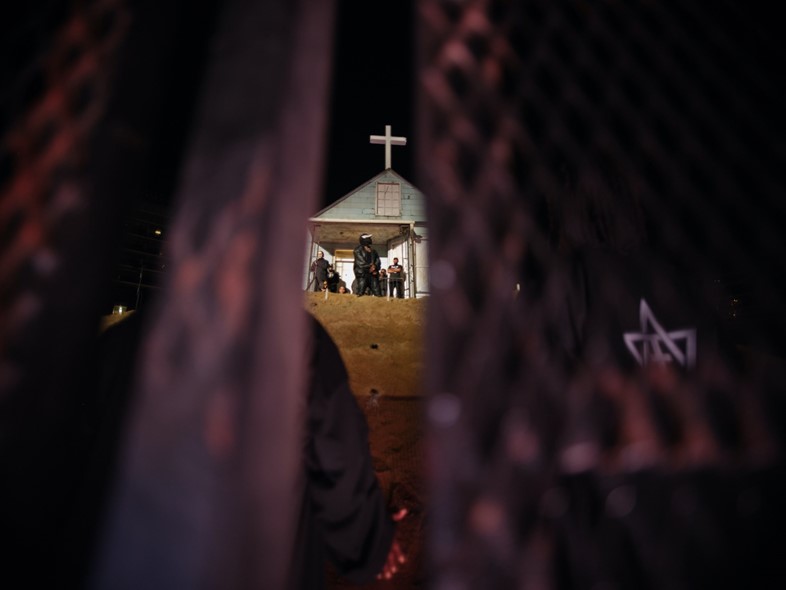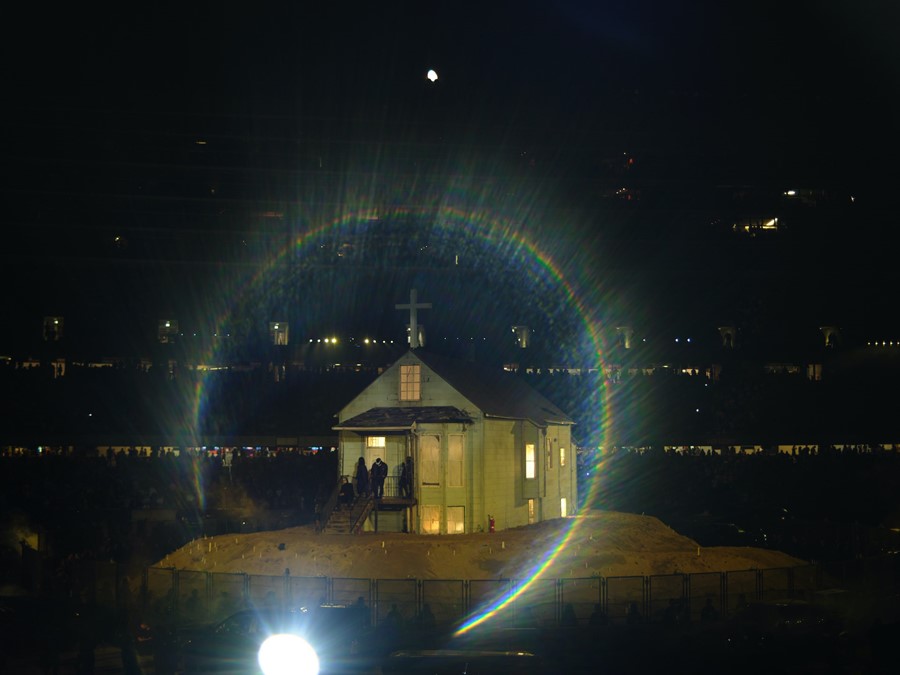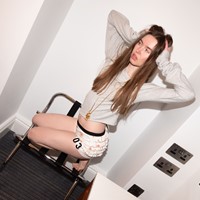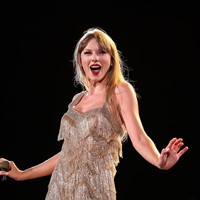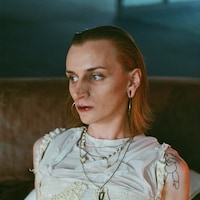As the much-delayed, controversial album finally gets its release, we unpack the symbolism and imagery at the heart of the rapper’s bombastic stadium set
At the centre of Chicago’s Soldier Field stadium on Thursday night sat a modest three-storey house, its wood siding painted a dusty light blue. Perched on a mound of dirt and circled by a black industrial fence, the building was a recreation of a working class suburban home from Chicago’s South Shore. Here, it was elevated to something nearing a religious shrine, laying in eerie silence as the assembled crowd of 38,000 fans excitedly jostled to their seats waiting for the show to start. There were murmurs of activity as silhouetted figures peered out from the lit windows; meanwhile, a trickle of shadowy, hooded worshippers or mourners arrived at this strange altar to light candles on the mound. On top of it all sat a white neon cross glowing like a beacon, reaching up to the heavens. Almost two hours after the scheduled start time, a deep, rumbling voice began stuttering the name Donda over and over, as if to announce that the spectacle was finally about to unfold.
This was Kanye West’s (or Ye, as his recent name change to a deity-like monosyllable goes) childhood home – but not as we know it. A replica created specifically for the third, and allegedly final, of his increasingly bombastic listening parties – the first two being held at Atlanta’s Mercedes-Benz Stadium, where West was reportedly holed up for weeks tweaking the record to the very last minute – it represented not just his Chicago homecoming, but also served as a tribute to his late mother, Dr. Donda C. West, after whom the new record is titled. Born in Oklahoma in 1949, Dr. West was a powerhouse professor of English; a single mother living in the majority Black neighbourhood of South Shore, where she raised Kanye to be the curious and wildly creative figure he would become; and finally, his manager and a guiding creative force when he first rocketed to fame in the early 2000s.
It’s been observed that Ye’s more erratic behavior first began after he struggled to recover emotionally from his mother’s untimely passing. In 2007, the day after a plastic surgery procedure, she died of coronary artery disease, with the cause of death likely brought about by having undergone the operation. Ye’s tributes to Donda since then have been frequent and passionate, coming in the form of performances of his 2005 track “Hey Mama” dedicated to her at his live shows, a t-shirt featuring a painting of Donda and “in loving memory” motif he sold alongside his YEEZY Season 3 collection in 2016, and even a piece of legislation passed by former California Governor Arnold Schwarzenegger in 2009 to enforce health screenings before elective cosmetic procedures, titled the Donda West Law.
Now, as the 14th anniversary of Donda’s death approaches this November, Ye has mounted his biggest tribute yet, spanning three concerts, two cities, and tens of thousands of attendees (and, if rumours are to be believed, millions of dollars of ticket and merch sales). While Ye is hardly known for his smooth album rollouts – nearly every album in his back catalogue was subject to multiple release date delays, last-minute title and artwork changes, or even tweaks made after the records had already been uploaded to streaming services – this time around, there appears to be a more clearly visible method to his madness.
There’s been an active dialogue with his fans as he develops the work in real time, switching out verses from a who’s who of rappers between shows, overhauling the production, and even removing entire tracks that were met with a more subdued reception. And in Chicago, the fans weren’t just feeding their responses back to Ye via their roaring cheers in the stadium, or across social media, but were actually participating in the event itself. Throughout the course of the evening, hundreds upon hundreds of his acolytes dressed in black t-shirts emblazoned with “Donda” filed into the field, sometimes running, other times slowed to a near stop, as hulking pick-up trucks licked with sleek black paint moved with them, circling the house at the set’s centre.
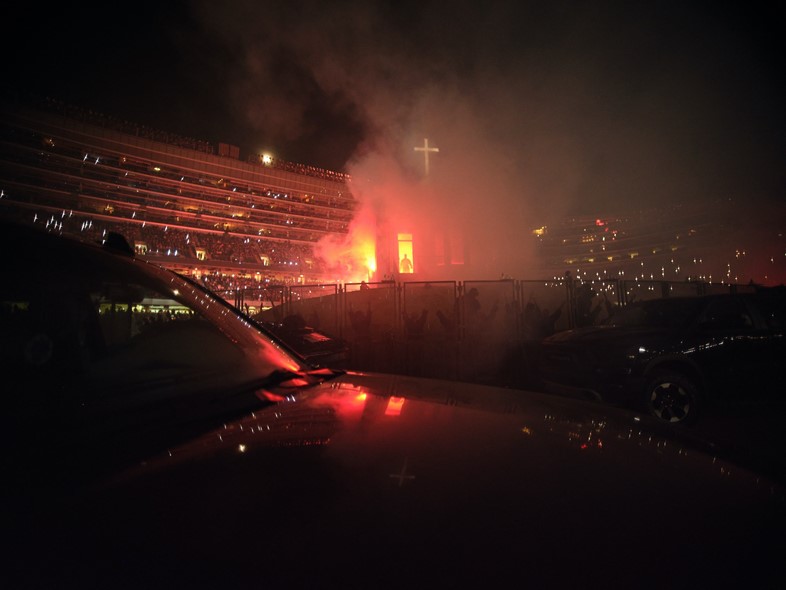
Where West shines is in the art of spectacle, and spectacular it certainly was. The show featured the kind of bombastic production values reserved for Olympics opening ceremonies or Super Bowl halftime shows. Towards the end, smoke began billowing from the house as it lit up with a sinister red glow as if on fire, before Ye (or at least a stunt double dressed as him) walked out onto the mound having appeared to set himself alight. Moments later, a mysterious figure later revealed to be none other than Kim Kardashian West began walking towards him, clad in a bridal gown that also happened to be the closing look of Demna Gvasalia’s brilliant couture debut for Balenciaga in July. Instead of being anything like a conventional vow renewal, however, it was a visual statement that paid testament to the restorative power of love, presented with the flair for showmanship that is characteristically Ye.
Still, what impressed most wasn’t these more fustian displays but the humble beauty of the house (or its replica in the stadium, at least). Like Dorothy’s Kansas home found deposited in another world in The Wizard of Oz, the displaced building possessed a strange, indescribable magnetism. It brought to mind the Italian town of Loreto, where there is a church believed to contain the home of the Virgin Mary, flown over by angels from Nazareth to the Marche region some time in the 13th century. As the circles of frenzied fans revolved ever closer to the house itself, they became pilgrims of a sort, paying tribute to Donda herself through the four walls in which she raised her son. It was the kind of broad, sweeping imagery that links the universal experience of Christianity with the mundanity of the everyday, that the typical suburban home represents – surely appealing to Ye’s offbeat theological framework, with his martyr-like self-immolation appearing to represent a process of purification or renewal.
